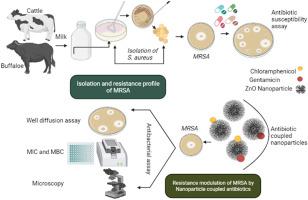Microbial Pathogenesis ( IF 3.8 ) Pub Date : 2021-08-12 , DOI: 10.1016/j.micpath.2021.105138 Fizzah Laeeq Lodhi 1 , Muhammad Ijaz Saleem 1 , Amjad Islam Aqib 2 , Imaad Rashid 1 , Zafar Iqbal Qureshi 3 , Muhammad Ahsan Anwar 1 , Fozia Ashraf 1 , Shanza Rauf Khan 4 , Huma Jamil 3 , Rabia Fatima 4 , Muhammad Kashif Javaid 5 , Iqra Muzammil 1 , Muhammad Aamir Naseer 1 , Muhammad Shoaib 6 , Qaisar Tanveer 7

|
The current study probed methicillin resistant S. aureus from milk of different dairy farms along with its response to multiple antibiotics, assessment of risk factors, and response to antibiotic coupled nanoparticle. XRD of Np was confirmed as miller indices (hkl) values i.e. (101), (100), (002), (110), (012) and (013) while STEM finally revealed 40–60 nm nanorods in aggregated form. Total of 6 preparations viz a viz gentamicin (G), chloramphenicol (C), zinc oxide nanoparticle (Np), gentamicin coupled Np (GNp), chloramphenicol coupled Np (CNp), and simultaneously coupling of gentamicin and chloramphenicol on Np (GCNp) were formulated for their potential to bring resistance modulation. Data analysis of this study revealed 24.59% MRSA from dairy milk appearing potentially associated (OR> 1, p < 0.05) with most of assumed risk factors. MRSA in response to various antibiotics showed highest resistance against amoxicillin (100%), penicillin (100%), vancomycin (100%), and linezolid (90%). Zone of inhibitions were increased by 249.76% (GNp), 184.86% (CNp), and 279.76% (GCNp) in case of coupled preparations. Significant reduced minimum inhibitory concentration was observed in case of GCNp (7.8125 ± 0.00 μg/mL) followed by GNp (15.00 ± 0.00 μg/mL) and CNp (41.67 ± 18.042 μg/mL) as compared to Np alone (125.00 ± 0.00 μg/mL). Minimum bactericidal concentrations for GCNp, GNp, and CNp, and Np were 31.125, 62.5, 125, and 500 μg/mL, respectively. The study thus concluded increased prevalence of MRSA while coupling of ZnO nanoparticles with antibiotics significantly brought resistance modulation to MRSA.
中文翻译:

通过抗生素偶联金属氧化物纳米颗粒对乳制品中流行的耐甲氧西林金黄色葡萄球菌进行耐药性调节
目前的研究从不同奶牛场的牛奶中探查了耐甲氧西林金黄色葡萄球菌及其对多种抗生素的反应、风险因素的评估以及对抗生素偶联纳米颗粒的反应。Np 的 XRD 被确认为米勒指数 (hkl) 值,即 (101)、(100)、(002)、(110)、(012) 和 (013),而 STEM 最终显示出 40-60 nm 的聚集形式的纳米棒。总共 6 个准备工作,即一个可视化庆大霉素 (G)、氯霉素 (C)、氧化锌纳米颗粒 (Np)、庆大霉素偶联 Np (GNp)、氯霉素偶联 Np (CNp),以及庆大霉素和氯霉素在 Np 上同时偶联 (GCNp) 的潜力电阻调制。该研究的数据分析显示,来自乳制品的 24.59% MRSA 似乎与大多数假定的风险因素有潜在关联(OR> 1,p < 0.05)。MRSA 对各种抗生素的反应显示出对阿莫西林 (100%)、青霉素 (100%)、万古霉素 (100%) 和利奈唑胺 (90%) 的最高耐药性。在偶联制剂的情况下,抑制区增加了 249.76% (GNp)、184.86% (CNp) 和 279.76% (GCNp)。在 GCNp (7.8125 ± 0.00 μg/mL) 和 GNp (15.00 ± 0.00 μg/mL) 和 CNp (41. 67 ± 18.042 μg/mL) 与单独的 Np (125.00 ± 0.00 μg/mL) 相比。GCNp、GNp、CNp 和 Np 的最低杀菌浓度分别为 31.125、62.5、125 和 500 μg/mL。因此,该研究得出结论,MRSA 的患病率增加,而 ZnO 纳米颗粒与抗生素的偶联显着带来了对 MRSA 的耐药性调节。



























 京公网安备 11010802027423号
京公网安备 11010802027423号